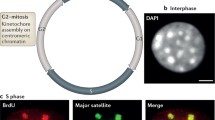Summary
Highly purified centromeric heterochromatin was isolated from mouse liver nuclei and the pattern of core histone variants was analyzed. In comparison with total chromatin, the centromeric heterochromatin of young animals was characterized by (1) enrichment in the replication-dependent variants H2A1, H2B2 and H32, (2) reduced amount of the minor variant H2Az and (3) absence of ubiquitinated molecules of H2A. This specific variant pattern changed upon ageing as a result of accumulation of replacement variants so that in adult animals both chromatin preparations exhibited similar pattern for H2A and H2B, while the difference in the profile of H3 variants was preserved.
Similar content being viewed by others
References
Grunstein M, Rykowski M, Kolorubetz D, Choe J, Wallis J: A genetic analysis of histone protein subtypes in yeast. In: GS Stein, JL Stein and WF Marzluff (eds), Historic Genes: Structure, Organization and Regulation. Wiley/Interscience, New York, 1984, p 35–55
Zweidler A: Core histone variants of the mouse: primary structure and differential expression. In: GS Stein, JL Stein, and WF Marzluff (eds), Histone Genes: Structure, Organization and Regulation. Wiley/Interscience, New York, 1984, pp 339–369
Newrock KM, Alfageme CR, Nardi RV, Cohen LH: Histone changes during chromatin remodelling in embryogenesis. Cold Spring Harbor Symp Quant Biol 42: 421–431, 1978
Poccia D: Remodelling of nucleoproteins during gametogenesis, fertilization, and early development. Internat Rev Cytol 105: 1–66, 1986
Blankstein ZA, Levy SB: Changes in histone f2a2 associated with proliferation of Friend leukaemic cells. Nature (London) 260: 638–640, 1976
Wu RS, Panusz HT, Hatch CL, Bonner WM: Histories and their modifications. CRC Critical Rev Biochem 20: 201–263,1986
Simpson RT: Modulation of nucleosome structure by histone subtypes in sea urchin embryos. Proc Natl Acad Sci USA 78: 6803–6808,1981
Benezra R, Blankstein LA, Stollar BD, Levy SB: Immunological and organizational heterogeneity of histone H2A variants within chromatin of cells at different stages of Friend leukemia. J Biol Chem 256: 6837–6841, 1981
Rao BJ, Brahmachari SK, Satyanarayana RMR: Structural organization of the meiotic prophase chromatin in the rat testis. J Biol Chem 258: 13478–13485, 1983
Venkov C, Russanova V, Ivanova V, Tsanev R: Differences in the mode of iodination of H2A variants in chromatin. Int J Biochem 17: 911–916, 1985
Ivanova V, Chipev C, Tsanev R: Reconstruction of chromatin core particles with histone variants H2al and H2a2. Int J Biol Macromol 9: 2–6, 1987
Allis CD, Richman R, Gorovsky MA, Ziegler YS, Touchstone B, Bradley WA, Cook RG: hvl is an evolutionarily conserved H2A variant that is preferentially associated with active genes. J Biol Chem 261: 1941–1948, 1986
Jasinskiene NE, Jasinkas AL, Gineitis AA: Distribution of histone variants in sea urchin chromatin fractions obtained by selective micrococcal nuclease digestion. Mol Biol Rep 10:199–203,1985
Donahne PR, Palmer DK, Condie JM, Sabatini LM, Blumenfeld M: Drosophila histone H2A.2 is associated with the interbands of polytene chromosomes. Proc Natl Acad Sci USA 83: 4744–4748, 1986
Blobel G, Potter V: Nuclei from rat liver: isolation method that combines purity with high yield. Science 154: 1662–1670,1966
Stephanova E, Russanova V, Chentsov Yu, Pashev I: Mouse centromeric heterochromatin: isolation and some characteristics. Exp Cell Res 179: 545–553
Panyim S, Chalkley R: High resolution acrylamide gel electrophoresis of histones. Arch Biochem Biophys 130: 337–346,1969
West MHP, Bonner WM: Histone 2A, a heteromorphous family of eight protein species. Biochemistry 19: 3238–3245,1980
Russanova V, Venkov C, Tsanev R: A comparison of histone variants in different rat tissues. Cell Differentiation 9: 339–350,1980
Zatsepina OV, Polyakov VY, Chentsov YS: Chromosoma and chromomere. Structure units of mitotic and interphase chromosomes. Chromosoma 88: 91–97, 1983
Levinger L, Varshavsky A: Selective arrangement of ubiquitinated and D1 protein containing nucleosomes within the Drosophila genome. Cell 28: 375–385, 1982
Pashev IG, Dimitrov SI, Ivanov IG, Markov GG: Histone acetylation in chromatin containing mouse satellite DNA. Eur J Biochem 133: 379–382, 1983
Halleck MS, Gurley LR: Histone variants and histone modifications in chromatin fractions from heterochromatin-rich Peromyscus cells. Exp Cell Res 138: 271–285, 1982
Gabrielli F, Hancock R, Faber AJ: Characterization of a chromatin fraction bearing pulse-labelled RNA. 2. Quantification of histones and HMG-proteins. Eur J Biochem 120: 363–369, 1981
Weber JL, Cole RD: Chromatin fragments containing bovine 1.715 g ml−1 satellite DNA. J Biol Chem 257: 11784–11790,1982
Tsanev R: Cell cycle and liver function. Results and problems in cell differentiation 7: 197–248, 1975
Jackson V, Chalkley R: Histone synthesis and deposition in the G1 and S phases of hepatoma tissue culture cells. Biochemistry 24: 6921–6930, 1985
Pantazis P, Bonner WM: Specific alteration in the pattern of histone-3 synthesis during conversion of human leukemic cells to terminally differentiated cells in culture. Differentiation 28: 186–190, 1984
Wunsch AM, Louch J: Modulation of histone H3 variant synthesis during the myoblast-myotube transition of chicken myogenesis. Develop Biol 119: 94–99, 1987
Tsanev R, Tsaneva I: Molecular organization of chromatin as revealed by electron microscopy. Meth Achiev Exp Path 12: 63–104, 1986
Tsanev R: Transcriptionally active chromatin. Mol Biol Rep 9: 9–17, 1983
Tsanev R, Petrov P: The substructure of chromatin and its variations as revealed by electron microscopy. J Microsc Biol Cell 27: 11–18, 1976
Oudet P, Spadafora C, Chambon P: Nucleosome structure: Structure of the SV 40 minichromosome and electron microscopic evidence for reversible transisitions of nucleosome structure. Cold Spring Harbor Symp Quant Biol 42: 301–312,1978
Allegra P, Sterner R, Clayton DF, Allfrey VG: Affinity chromatographic purification of nucleosomes containing transcriptionally active DNA sequences. J Mol Biol 196: 379–388,1987
Author information
Authors and Affiliations
Rights and permissions
About this article
Cite this article
Russanova, V., Stephanova, E., Pashev, I. et al. Histone variants in mouse centromeric chromatin. Mol Cell Biochem 90, 1–7 (1989). https://doi.org/10.1007/BF00225215
Received:
Accepted:
Issue Date:
DOI: https://doi.org/10.1007/BF00225215




